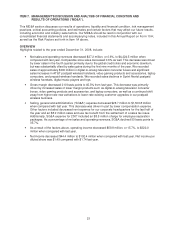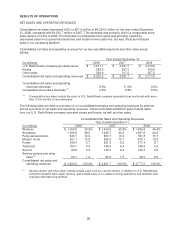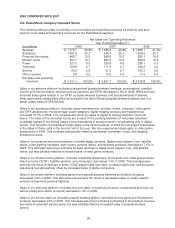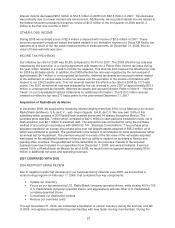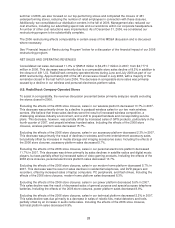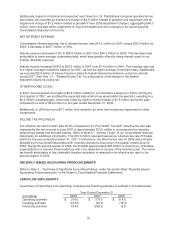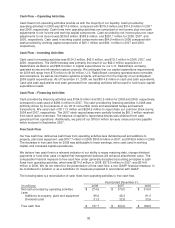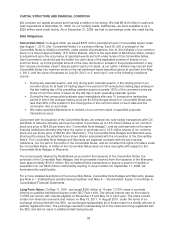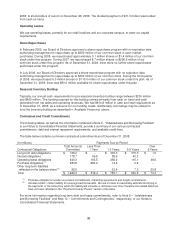Radio Shack 2008 Annual Report Download - page 37
Download and view the complete annual report
Please find page 37 of the 2008 Radio Shack annual report below. You can navigate through the pages in the report by either clicking on the pages listed below, or by using the keyword search tool below to find specific information within the annual report.of certain class action lawsuits during 2006, as well as prior year recognition of $5.1 million of the $8.8
million charge to establish a legal reserve for the settlement of these lawsuits. See Note 12 –
“Commitments and Contingencies” in the Notes to Consolidated Financial Statements for a discussion of
these lawsuits.
DEPRECIATION AND AMORTIZATION
Total depreciation and amortization for 2007 declined $15.5 million or 12.1%. This decrease was primarily
due to the closure of stores and acceleration of depreciation as part of our 2006 restructuring, as well as a
reduction in our capital expenditures during 2007. Additionally, the 2007 decline within the kiosk segment
was the result of an impairment recorded during the third quarter of 2006.
IMPAIRMENT OF LONG-LIVED ASSETS AND OTHER CHARGES
During 2007, we recorded impairment charges for long-lived assets related primarily to our Sprint Nextel
kiosk operations and U.S. RadioShack company-operated stores of $2.7 million. We recorded this amount
based on the remaining estimated future cash flows related to these specific stores. It was determined that
the net book value of many of the stores' long-lived assets was not recoverable. For the stores with
insufficient estimated cash flows, we wrote down the associated long-lived assets to their estimated fair
value.
In February 2006, as part of our restructuring program, our board of directors approved the closure of 400
to 700 U.S. RadioShack company-operated stores. During the first half of 2006, we identified the stores
for closure and subsequently performed the impairment test. Based on the remaining estimated future
cash flows related to these specific stores, it was determined that the net book value of some of the
stores' long-lived assets to be held for use was not recoverable. For the stores with insufficient estimated
cash flows, we wrote down the associated long-lived assets to their estimated fair value, resulting in a $9.2
million impairment loss related to our U.S. RadioShack company-operated store segment. By July 31,
2006, we had closed 481 specific stores under the restructuring program; there were no additional
closures under this program for the remainder of the year.
Also, we purchased certain assets from Wireless Retail, Inc. during the fourth quarter of 2004 for $59.6
million, which resulted in the recognition of $18.6 million of goodwill and a $32.1 million intangible asset
related to a five-year agreement with Sam’s Club to operate wireless kiosks in approximately 540 Sam’s
Club locations nationwide. These assets relate to our kiosk segment. As a result of continued company
and wireless industry growth challenges, together with changes in our senior leadership team during the
third quarter of 2006 that resulted in a refocus on allocation of capital and resources towards other areas
of our business, we determined that our long-lived assets, including goodwill associated with our kiosk
operations, were impaired. We performed impairment tests on both the long-lived assets associated with
our Sam’s Club agreement, including the intangible asset relating to the five-year agreement, and the
accompanying goodwill.
With respect to the long-lived tangible and intangible assets, we compared their carrying values with their
estimated fair values using a discounted cash flow model, which reflected our lowered expectations of
wireless revenue growth and the ceased expansion of our kiosk business, and determined that the
intangible asset relating to the five-year agreement was impaired. This assessment resulted in a $10.7
million impairment charge to the intangible asset related to our kiosk segment in 2006. The remaining
intangible balance is being amortized over the remaining life of the Sam’s Club agreement, which was
originally scheduled to expire in September 2009.
With respect to the goodwill of $18.6 million, we estimated the fair value of the Sam’s Club reporting unit
using a discounted cash flow model similar to that used in the long-lived asset impairment test. We
compared it with the carrying value of the reporting unit and determined that the goodwill was impaired.
As the carrying value of the reporting unit exceeded its estimated fair value, we then compared the implied
fair value of the reporting unit's goodwill with the carrying amount of goodwill. This resulted in an $18.6
million impairment of goodwill related to our kiosk segment in 2006.
30
Professional fees decreased in both dollars and as a percent of net sales and operating revenues. The
decrease relates to a decline in our use of consultants and lower fees incurred as a result of our defense



